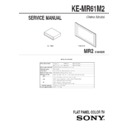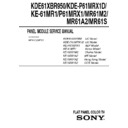Sony KE-MR61M2 Service Manual ▷ View online
KE-MR61M2 (CH) 2
Design and specifications are subject to change without notice.
WOOFER OUT (VAR)
i (Headphones)
Display resolution
Screen size
Dimensions (w/h/d, mm)
Mass (kg)
Output: 1
Phono jack
Output: 1
Stereo minijack
1365 pixels
× 768 pixels
61 inches
Display unit
PDM-6110:
Media receiver unit
MBT-MR2:
430
× 79 × 343 mm
1797
× 937 × 110 mm
Display unit
PDM-6110:
71 kg
Media receiver unit
MBT-MR2:
4.7 kg
Number of terminal
VIDEO (Video)
AUDIO (Audio)
S VIDEO
(S Video)
COMPONENT
VIDEO IN
(Component Video)
(Component Video)
COMPONENT
VIDEO IN
(G/B/R/HD/VD
Video)
(G/B/R/HD/VD
Video)
5
PC– CENTER SP IN
(Center Speaker)
Input: 4 Output: 1
Phono jacks; 1 Vp-p, 75 ohms
Input: 6 Output: 1
Phono jacks; 500 mVrms
Input: 4
Y: 1 Vp-p, 75 ohms,
unbalanced, sync negative
C: 0.286 Vp-p, 75 ohms
C: 0.286 Vp-p, 75 ohms
Input: 2
Phono jacks
Y: 1 Vp-p, 75 ohms, sync negative
PB/CB: 0.7 Vp-p, 75 ohms
PR/CR: 0.7 Vp-p, 75 ohms
Audio: 500 mVrms
Y: 1 Vp-p, 75 ohms, sync negative
PB/CB: 0.7 Vp-p, 75 ohms
PR/CR: 0.7 Vp-p, 75 ohms
Audio: 500 mVrms
Input: 1
Phono jacks
G: 0.7 Vp-p, 75 ohms
B: 0.7 Vp-p, 75 ohms
R: 0.7 Vp-p, 75 ohms
HD: 0.7 Vp-p, 75 ohms
VD: 0.7 Vp-p, 75 ohms
G: 0.7 Vp-p, 75 ohms
B: 0.7 Vp-p, 75 ohms
R: 0.7 Vp-p, 75 ohms
HD: 0.7 Vp-p, 75 ohms
VD: 0.7 Vp-p, 75 ohms
Input:1
120 W max., 8 ohms
KE-MR61M2 (CH) 3
SAFETY CHECK-OUT
After correcting the original service problem, perform the
following safety checks before releasing the set to the customer:
1. Check the area of your repair for unsoldered or poorly-sol-
following safety checks before releasing the set to the customer:
1. Check the area of your repair for unsoldered or poorly-sol-
dered connections. Check the entire board surface for solder
splashes and bridges.
splashes and bridges.
2. Check the interboard wiring to ensure that no wires are
“pinched” or contact high-wattage resistors.
3. Check that all control knobs, shields, covers, ground straps,
and mounting hardware have been replaced. Be absolutely cer-
tain that you have replaced all the insulators.
tain that you have replaced all the insulators.
4. Look for unauthorized replacement parts, particularly transis-
tors, that were installed during a previous repair. Point them
out to the customer and recommend their replacement.
out to the customer and recommend their replacement.
5. Look for parts which, though functioning, show obvious signs
of deterioration. Point them out to the customer and recom-
mend their replacement.
mend their replacement.
6. Check the line cords for cracks and abrasion. Recommend the
replacement of any such line cord to the customer.
7. Check the antenna terminals, metal trim, “metallized” knobs,
screws, and all other exposed metal parts for AC Leakage.
Check leakage as described right.
Check leakage as described right.
LEAKAGE TEST
The AC leakage from any exposed metal part to earth ground and
from all exposed metal parts to any exposed metal part having a
return to chassis, must not exceed 0.5 mA (500 microamperes).
Leakage current can be measured by any one of three methods.
1. A commercial leakage tester, such as the Simpson 229 or RCA
The AC leakage from any exposed metal part to earth ground and
from all exposed metal parts to any exposed metal part having a
return to chassis, must not exceed 0.5 mA (500 microamperes).
Leakage current can be measured by any one of three methods.
1. A commercial leakage tester, such as the Simpson 229 or RCA
WT-540A. Follow the manufacturers’ instructions to use these
instruments.
instruments.
2. A battery-operated AC milliammeter. The Data Precision 245
digital multimeter is suitable for this job.
3. Measuring the voltage drop across a resistor by means of a
VOM or battery-operated AC voltmeter. The “limit” indica-
tion is 0.75 V, so analog meters must have an accurate low-
voltage scale. The Simpson 250 and Sanwa SH-63Trd are ex-
amples of a passive VOMs that are suitable. Nearly all battery
operated digital multimeters that have a 2 V AC range are suit-
able. (See Fig. A)
tion is 0.75 V, so analog meters must have an accurate low-
voltage scale. The Simpson 250 and Sanwa SH-63Trd are ex-
amples of a passive VOMs that are suitable. Nearly all battery
operated digital multimeters that have a 2 V AC range are suit-
able. (See Fig. A)
Fig. A. Using an AC voltmeter to check AC leakage.
1.5 k
Ω
0.15
µF
AC
Voltmeter
(0.75 V)
Voltmeter
(0.75 V)
To Exposed Metal
Parts on Set
Parts on Set
Earth Ground
WARNING!!
SAFETY-RELATED COMPONENT WARNING!!
COMPONENTS IDENTIFIED BY SHADING AND MARK
!
ON THE SCHEMATIC DIAGRAMS, EXPLODED VIEWS
AND IN THE PARTS LIST ARE CRITICAL FOR SAFE
OPERATION. REPLACE THESE COMPONENTS WITH
SONY PARTS WHOSE PART NUMBERS APPEAR AS
SHOWN IN THIS MANUAL OR IN SUPPLEMENTS PUB-
LISHED BY SONY. CIRCUIT ADJUSTMENTS THAT ARE
CRITICAL FOR SAFE OPERATION ARE IDENTIFIED IN
THIS MANUAL. FOLLOW THESE PROCEDURES WHEN-
EVER CRITICAL COMPONENTS ARE REPLACED OR
IMPROPER OPERATION IS SUSPECTED.
AND IN THE PARTS LIST ARE CRITICAL FOR SAFE
OPERATION. REPLACE THESE COMPONENTS WITH
SONY PARTS WHOSE PART NUMBERS APPEAR AS
SHOWN IN THIS MANUAL OR IN SUPPLEMENTS PUB-
LISHED BY SONY. CIRCUIT ADJUSTMENTS THAT ARE
CRITICAL FOR SAFE OPERATION ARE IDENTIFIED IN
THIS MANUAL. FOLLOW THESE PROCEDURES WHEN-
EVER CRITICAL COMPONENTS ARE REPLACED OR
IMPROPER OPERATION IS SUSPECTED.
AVERTISSEMENT!!
ATTENTION AUX COMPOSANTS RELATIFS À LA
SÉCURITÉ!!
LES COMPOSANTS IDENTIFIÉS PAR UNE TRAME ET
UNE MARQUE ! SONT CRITIQUES POUR LA
SÉCURITÉ. NE LES REMPLACER QUE PAR UNE
PIÈCE PORTANT LE NUMÉRO SPECIFIÉ. LES
RÉGLAGES DE CIRCUIT DONT L’IMPORTANCE EST
CRITIQUE POUR LA SÉCURITÉ DU
FONCTIONNEMENT SONT IDENTIFIÉS DANS LE
PRÉSENT MANUEL. SUIVRE CES PROCÉDURES
LORS DE CHAQUE REMPLACEMENT DE
COMPOSANTS CRITIQUES, OU LORSQU’UN MAUVAIS
FONCTIONNEMENT EST SUSPECTÉ.
SÉCURITÉ!!
LES COMPOSANTS IDENTIFIÉS PAR UNE TRAME ET
UNE MARQUE ! SONT CRITIQUES POUR LA
SÉCURITÉ. NE LES REMPLACER QUE PAR UNE
PIÈCE PORTANT LE NUMÉRO SPECIFIÉ. LES
RÉGLAGES DE CIRCUIT DONT L’IMPORTANCE EST
CRITIQUE POUR LA SÉCURITÉ DU
FONCTIONNEMENT SONT IDENTIFIÉS DANS LE
PRÉSENT MANUEL. SUIVRE CES PROCÉDURES
LORS DE CHAQUE REMPLACEMENT DE
COMPOSANTS CRITIQUES, OU LORSQU’UN MAUVAIS
FONCTIONNEMENT EST SUSPECTÉ.
KE-MR61M2 (CH) 4
SELF DIAGNOSIS FUNCTION
1. Outline of Self-Diagnosis Function
• This device includes a self-diagnosis function.
• In case of abnormalities, the POWER/STANDBY indicator sutomatically blinks.
• It is possible to predict the sbnormality location by the number of blinks.
• The instruction manual describes blinking of the POWER/STANDBY indicator.
• If the symptom is not reproduced sometime in case of a malfunction, there is recording of whether a malfunction was generated or
not.
Operate the remote command to confirm the matter on the screen and to predict the location of the abnormality.
Operate the remote command to confirm the matter on the screen and to predict the location of the abnormality.
2. Diagnosis Iteams and Prediction of Malfunction Location
• When a malfunction occure the POWER/STANDBY indicators only blinks for one of the following diagnosis items.
• In case of two or more malfunctions, the item which first occurred blinks.
If the malfunctions occurred simultaneously, the item whith the lower blink count blinks first.
<Maifunction location by the number of blinks>
Number of times
symptom
POWER/STANDBY
Indicators blinks
Indicators blinks
4 times (RED)
Fan Error
6 times (RED)
Low-B Error
9 times (RED)
Panel Module Error (Display Unit Error)
KE-MR61M2 (CH) 5
TABLE OF CONTENTS
SAFETY CHECK-OUT .......................................
3
SELF DIAGNOSIS FUNCTION ..........................
4
1. DISASSEMBLY ............................................ 1-1
1-1.
DISPLAY UNIT (PDM-6110) ........................... 1-1
1-1-1. REAR COVER REMOVAL ......................... 1-1
1-1-2. G1 BOARD REMOVAL ............................... 1-2
1-1-3. F1 AND K2 BOARDS REMOVAL ............. 1-2
1-1-4. DEM AND K3 BOARDS REMOVAL ......... 1-3
1-1-5. G2 BOARD REMOVAL ............................... 1-3
1-1-6. SPEAKER BOX ASSY REMOVAL ............ 1-4
1-1-7. FILTER GLASS BRACKET ASSY REMOVAL
........................................................................ 1-5
1-1-8. R1 BOARD REMOVAL ............................... 1-6
1-1-9. R2 BOARD REMOVAL ............................... 1-6
1-1-10. PLASMA DISPLAY PANEL REMOVAL
........................................................................ 1-7
1-2.
MEDIA RECEIVER UNIT (MBT-MR2) ......... 1-8
1-2-1. PANEL AND COVERS REMOVAL ........... 1-8
1-2-2. SPM BOARD REMOVAL ............................ 1-9
1-2-3. H1, H2 AND H3 BOARDS REMOVAL ...... 1-9
1-2-4. HM BOARD REMOVAL ............................. 1-10
1-2-5. J1 AND J2 BOARDS REMOVAL ............... 1-10
1-2-6. BD, M AND MS2 BOARDS REMOVAL .... 1-11
1-2-7. A BOARD REMOVAL ................................. 1-12
1-2-8. G BOARD REMOVAL ................................. 1-12
2. ADJUSTMENT .............................................. 2-1
2-1.
SERVICE MODE ............................................... 2-1
2-1-1. METHOD OF SETTING THE
SERVICE MODE. ......................................... 2-1
2-1-2. ADJUSTMENT ITEMS AND
KEY OPERATION. ....................................... 2-1
2-1-3. METHOD OF ENDING
SERVICE MODE .......................................... 2-1
2-1-4. SERVICE MODE LIST ................................. 2-2
3. DIAGRAMS ................................................... 3-1
3-1.
BLOCK DIAGRAMS ........................................ 3-1
3-1-1. DISPLAY UNIT (PDM-6110) ...................... 3-1
(1)
DEM, R1 and R2 Boards ............................... 3-1
(2)
K2 and K3 Boards .......................................... 3-2
(3)
F1 and G1 Boards .......................................... 3-3
(4)
G2 Board ........................................................ 3-4
3-1-2. MEDIA RECEIVER UNIT (MBT-MR2) ..... 3-5
(1)
A (1/2) and H1 (1/2) Boards .......................... 3-5
(2)
A (2/2), H1 (1/2), H2, H3 and
SPM Boards ................................................... 3-6
(3)
J1 Board ......................................................... 3-7
(4)
HM and MS2 Boards ..................................... 3-8
(5)
BD Board ....................................................... 3-9
(6)
J2 and M (1/2) Boards ................................... 3-10
(7)
M (2/2) Board ................................................. 3-11
(8)
G Board .......................................................... 3-12
3-2.
FRAME DIAGRAM .......................................... 3-13
3-3.
CIRCUIT BOARDS LOCATION ..................... 3-14
3-3-1. DISPLAY UNIT (PDM-6110) ...................... 3-14
3-3-2. MEDIA RECEIVER UNIT (MBT-MR2) ..... 3-14
3-4.
SCHEMATIC DIAGRAMS AND PRINTED
WIRING BOARDS ............................................ 3-14
3-4-1. DISPLAY UNIT (PDM-6110) ...................... 3-15
(1)
Schematic Diagram of DEM Board .............. 3-15
(2)
Schematic Diagram of F1 Board ................... 3-23
(3)
Schematic Diagram of G1 Board .................. 3-24
(4)
Schematic Diagram of G2 Board .................. 3-26
(5)
Schematic Diagram of K2 Board .................. 3-28
(6)
Schematic Diagram of K3 Board .................. 3-30
(7)
Schematic Diagram of R1 Board ................... 3-31
(8)
Schematic Diagram of R2 Board ................... 3-31
3-4-2. MEDIA RECEIVER UNIT (MBT-MR2) ...... 3-32
(1)
Schematic Diagram of A Board .................... 3-32
(2)
Schematic Diagram of BD Board .................. 3-38
(3)
Schematic Diagram of G Board .................... 3-44
(4)
Schematic Diagram of H1 Board .................. 3-46
(5)
Schematic Diagrams of H2 and H3 Boards .. 3-47
(6)
Schematic Diagram of HM Board ................. 3-48
(7)
Schematic Diagram of J1 Board .................... 3-49
(8)
Schematic Diagrams of J2 and SPM Boards . 3-51
(9)
Schematic Diagram of M Board .................... 3-52
(10) Schematic Diagram of MS2 Board ................ 3-56
3-5.
SEMICONDUCTORS ....................................... 3-61
4. EXPLODED VIEWS ...................................... 4-1
4-1.
DISPLAY UNIT-1 (PDM-6110) ....................... 4-2
4-1-1. DISPLAY UNIT-1 ......................................... 4-2
4-1-2. DISPLAY UNIT-2 ......................................... 4-3
4-1-3. DISPLAY UNIT-3 ......................................... 4-4
4-1-4. DISPLAY UNIT-4 ......................................... 4-5
4-2.
MEDIA RECEIVER UNIT (MBT-MR2) ......... 4-6
4-2-1. MEDIA RECEIVER UNIT-1 ........................ 4-6
4-2-2. MEDIA RECEIVER UNIT-2 ........................ 4-7
4-2-3. MEDIA RECEIVER UNIT-3 ........................ 4-8
4-2-4. MEDIA RECEIVER UNIT-4 ........................ 4-9
4-3.
PACKING MATERIALS FOR DISPLAY UNIT
(PDM-6110) ...................................................... 4-10
4-4.
PACKING MATERIALS FOR MEDIA
RECEIVER UNIT (MBT-MR2) ........................ 4-11
5. ELECTRICAL PARTS LIST ........................ 5-1


